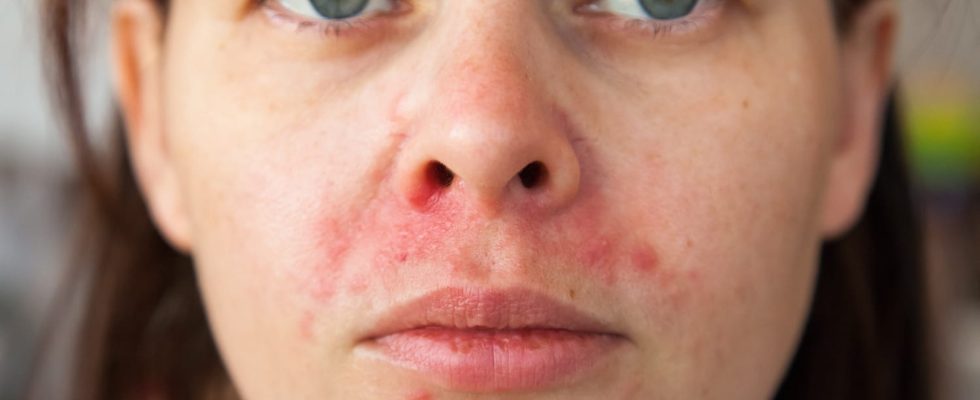Perioral dermatitis resembles eczema or acne and manifests itself as redness around the mouth, wrinkles in the nose and chin, often in young women.
Perioral dermatitis manifests itself by redness around the mouth, wrinkles in the nose and chin, often at a young woman (Before 50 years). She looks like eczema, acne or rosacea. It’s about a common complication of untimely or prolonged application of topical corticosteroids on the face.
What is perioral dermatitis?
Perioral or perioral dermatitis is “a skin disease especially touching young women of childbearing age, and characterized by a perioral rash (around the mouth, editor’s note) going up towards the wings of the nose, as well as by the appearance of small papules, pustules or papulopustules on an erythematous and sometimes scaly background“defines theAcademy of Medicine. It is not contagious. Young women and children are more affected.
What are the symptoms of perioral dermatitis?
Perioral dermatitis is characterized by erythema – of the “ring” redness – at the level of the skin which surrounds the mouth, folds of the nose and chinwith some flaking generally limited to the perioral area. “The redness is sometimes covered with papules or pustules, hence this resemblance to acne, or with scales, giving often very dry appearance“, explains Dr. Pierre-André Bécherel, dermatologist. She is moderately itchyin other words it does not itch much, but it is frequently associated with burning sensation. Sometimes it extends to the nose and eyes and, very rarely, to the genitals.
What causes perioral dermatitis?
“The majority of cases of perioral dermatitis appear to be caused by prolonged use of topical corticosteroids in this area”, reports the Academy of Medicine. Topical corticosteroids are ointments, creams and lotions containing corticosteroids/cortisone For example Diprosone®. “Much more rarely we can detect a food allergy“, underlines our interlocutor. Certain oily cosmetics, like very rich moisturizers, tend to make the disorder worse and should also be stopped. Perioral dermatitis generally affects young women, but also children who present a “licking tic” (repeatedly licking the edges of the lips, for no apparent reason)
How long does perioral dermatitis take to heal?
Typically, perioral dermatitis disappears spontaneously within a few weeks after stopping the triggering product.
The diagnosis is based on the clinical aspect. Clinical examination of the skin should rule out the diagnoses of acne (perioral dermatitis is associated with an absence of blackheads and comedones), rosacea (rosacea is associated with an absence of lesions around the mouth and eyes), eczema, seborrheic dermatitis and contact dermatitis.
What treatment to treat perioral dermatitis?
“Stopping applications of topical corticosteroids and prescribing tetracyclines (an ointment or oral antibiotic) constitute an effective treatment”, indicates the Academy of Medicine. Avène Cicalfate® cream can calm irritations.
Thanks to Dr Pierre-André Bécherel, dermatologist at the Antony private hospital (91), and member of RESOa collaborative medicine network
